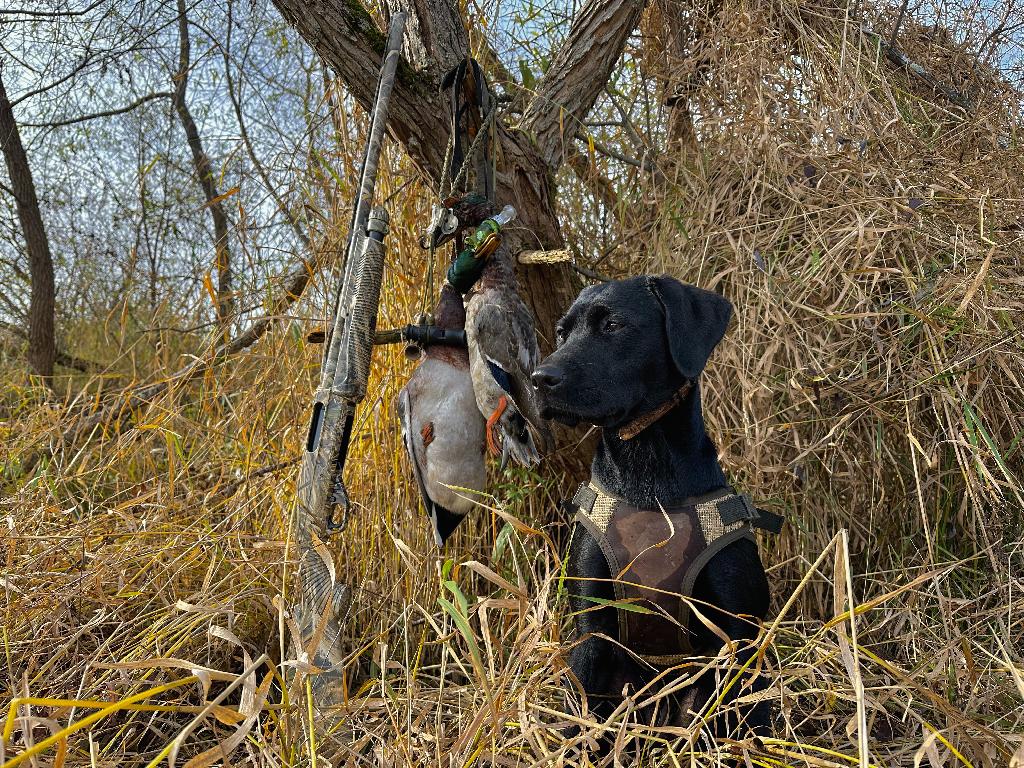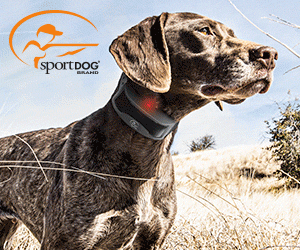Retriever Safety
Posted 03/17/2025
With a heave, I pulled my foot free of the thick muck, I wondered if another half mile of this was worth the trouble. The edge of this particular beaver pond seemed solid enough, but I had slogged far enough to find out that wasn’t the case. The previous day, a group of mallards were feeding on the far end of the hellish mire, and the decision was made to return with a couple dozen decoys. Behind me, my black lab was having a harder time than I was, the mud was clutching at her belly and legs, and the sharp ends of gnawed-off sticks protruded through the loamy sludge. Up ahead the mallards quacked and whistled tauntingly. Despite the temptation, I decided to turn back. To me, no duck is worth potentially injuring my dog.

Waterfowling is arguably one of the most physically demanding sports that the outdoors can offer. The harsh conditions of deep water, thick mud, cold weather, and hidden obstructions can create an array of dangers and obstacles for waterfowlers. Competition and pressure can oftentimes push ducks to remote and hard-to-reach places, and many duck hunters pursue them in hopes of bagging a limit. Amidst the struggles, it is easy for us to forget our faithful companions — our retrievers. With so many factors contributing to the danger of hunting waterfowl, we must also take the proper precautions to keep our hunting partners safe.

One of the most overlooked perils is submerged sticks. These are especially common in areas with beaver activity or flooded timber, their sharp ends can put a dog out for a season — or worse. While hunting in areas with these hazards, it may be a better idea to leave your dog at home to avoid the risk altogether — though I have hunted a good number of beaver ponds littered with gnawed sticks. In fact, wood ducks love them. And I have spent a considerable amount of time hunting them in an old beaver flooding not 15 minutes from my house. After clearing out the area where my dog will be making most of her retrieves, I feel that she is safe enough to continue her work. Aside from this, a protective dog vest is also recommended for additional assurance. Some vests feature protective skid plates to help deflect offending debris, which can greatly help avoid the risk of serious injury. It is always a good idea to carry a canine med kit in your blind bag as well. Though it might take up a lot of space, it could potentially save your dog's life.

Thick mud is another common problem for retrievers, as it is notorious for causing injuries. A dog that tries sprinting for downed ducks may pull a muscle or sprain a joint in the clinging muck. Try and avoid running your dog in these types of areas, especially if they are the hard-driving type or in their later years of life. If it is necessary, pick your shots carefully in hopes of dropping birds in relatively clean water or on solid ground.

Ice is a familiar sight and a dangerous obstacle in the later months of the season. While frozen conditions can oftentimes generate good hunting, they can be a detriment to our gun dogs as well. Thick ice can be treacherous, and though it may support a dog's weight at first, it could give way at any moment. Combine this with deep water, and it can quickly become a life-threatening situation for a wildfowler attempting to rescue a struggling retriever. Thin ice provides its own set of complications. The shards it creates can cut skin and foot pads alike. While many dogs may be able to tough it out, it still may not be what is best for them. Aside from its abrasive nature, it can make the task of swimming for basic retrieves much more difficult. I recall a hunt where my young dog was struggling against the current and ice floes of a coagulated river to reach a downed mallard. Had she been older, tired, or something gone awry, it could have quickly become a dangerous situation — and that has caused me to think twice ever since. Truly, I don’t know how I would have saved her. Another issue is chilly air and colder water, which also pose a risk of hypothermia. A well-fitted and insulated vest made of neoprene can provide extra insulation and flotation on those frigid days. When the mercury gets down into the single digits though, it may be better to leave your pup at home and get some exercise picking up ducks yourself. However, if you plan on taking your retriever, pick your shots carefully and read their behavior. If your dog is typically eager to go on marks and becomes hesitant, take the time to consider what is best for their well-being.

The opposite end of the spectrum is hot weather. During the hot summer months when temperatures soar into the eighties, nineties, and higher, the risk of heat stroke increases exponentially. This is especially crucial for Labrador Retrievers, which are much more resistant to colder temperatures than hot ones. During these waves of hot weather, it may be best to give your companion a break until the temps cool down. But, if you do plan to work your dog, keep the training sessions short and be sure there is plenty of water and shade available to them. If I am training my dog in stifling heat, I am sure there is always a body of water or even a small kiddie pool nearby for her to cool off in.

Ultimately, the safety of your dog should be paramount. A good retriever will do just about anything for us. So it is our responsibility to do whatever it takes to keep them safe and healthy. It pays to take the time to prepare and evaluate the situation to keep them out of harm's way, as I have always felt it is better to err on the side of caution rather than wish I would have.

Waterfowling is arguably one of the most physically demanding sports that the outdoors can offer. The harsh conditions of deep water, thick mud, cold weather, and hidden obstructions can create an array of dangers and obstacles for waterfowlers. Competition and pressure can oftentimes push ducks to remote and hard-to-reach places, and many duck hunters pursue them in hopes of bagging a limit. Amidst the struggles, it is easy for us to forget our faithful companions — our retrievers. With so many factors contributing to the danger of hunting waterfowl, we must also take the proper precautions to keep our hunting partners safe.

One of the most overlooked perils is submerged sticks. These are especially common in areas with beaver activity or flooded timber, their sharp ends can put a dog out for a season — or worse. While hunting in areas with these hazards, it may be a better idea to leave your dog at home to avoid the risk altogether — though I have hunted a good number of beaver ponds littered with gnawed sticks. In fact, wood ducks love them. And I have spent a considerable amount of time hunting them in an old beaver flooding not 15 minutes from my house. After clearing out the area where my dog will be making most of her retrieves, I feel that she is safe enough to continue her work. Aside from this, a protective dog vest is also recommended for additional assurance. Some vests feature protective skid plates to help deflect offending debris, which can greatly help avoid the risk of serious injury. It is always a good idea to carry a canine med kit in your blind bag as well. Though it might take up a lot of space, it could potentially save your dog's life.

Thick mud is another common problem for retrievers, as it is notorious for causing injuries. A dog that tries sprinting for downed ducks may pull a muscle or sprain a joint in the clinging muck. Try and avoid running your dog in these types of areas, especially if they are the hard-driving type or in their later years of life. If it is necessary, pick your shots carefully in hopes of dropping birds in relatively clean water or on solid ground.

Ice is a familiar sight and a dangerous obstacle in the later months of the season. While frozen conditions can oftentimes generate good hunting, they can be a detriment to our gun dogs as well. Thick ice can be treacherous, and though it may support a dog's weight at first, it could give way at any moment. Combine this with deep water, and it can quickly become a life-threatening situation for a wildfowler attempting to rescue a struggling retriever. Thin ice provides its own set of complications. The shards it creates can cut skin and foot pads alike. While many dogs may be able to tough it out, it still may not be what is best for them. Aside from its abrasive nature, it can make the task of swimming for basic retrieves much more difficult. I recall a hunt where my young dog was struggling against the current and ice floes of a coagulated river to reach a downed mallard. Had she been older, tired, or something gone awry, it could have quickly become a dangerous situation — and that has caused me to think twice ever since. Truly, I don’t know how I would have saved her. Another issue is chilly air and colder water, which also pose a risk of hypothermia. A well-fitted and insulated vest made of neoprene can provide extra insulation and flotation on those frigid days. When the mercury gets down into the single digits though, it may be better to leave your pup at home and get some exercise picking up ducks yourself. However, if you plan on taking your retriever, pick your shots carefully and read their behavior. If your dog is typically eager to go on marks and becomes hesitant, take the time to consider what is best for their well-being.

The opposite end of the spectrum is hot weather. During the hot summer months when temperatures soar into the eighties, nineties, and higher, the risk of heat stroke increases exponentially. This is especially crucial for Labrador Retrievers, which are much more resistant to colder temperatures than hot ones. During these waves of hot weather, it may be best to give your companion a break until the temps cool down. But, if you do plan to work your dog, keep the training sessions short and be sure there is plenty of water and shade available to them. If I am training my dog in stifling heat, I am sure there is always a body of water or even a small kiddie pool nearby for her to cool off in.

Ultimately, the safety of your dog should be paramount. A good retriever will do just about anything for us. So it is our responsibility to do whatever it takes to keep them safe and healthy. It pays to take the time to prepare and evaluate the situation to keep them out of harm's way, as I have always felt it is better to err on the side of caution rather than wish I would have.





















